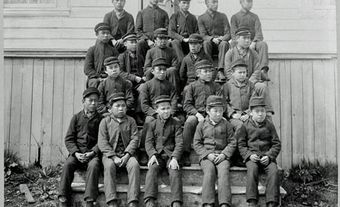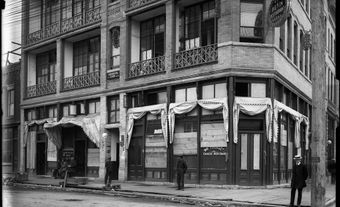Historically, many schools kept Black Canadians separate from white Canadians. Racial segregation policies excluded and limited Black Canadians’ rights. Some universities denied admission to Black people on the basis of their race. (See Anti-Black Racism in Canada.) This was particularly the case for medical and nursing programs.
Primary Schools
In the early 19th century, the provincial governments of Ontario and Nova Scotia created legally segregated common schools. These were also known as public schools. In the early 1840s, the public school structure was formalized in Canada. (See History of Education in Canada; Separate School.) Ontario school trustees (who were all white) created separate schools for Black children in certain parts of southwestern Ontario. This was particularly the case in areas where there were many recently arrived freedom seekers. (See Fugitive Slave Act of 1850.) Some trustees tampered with electoral boundaries to prevent Black children from attending certain schools. This forced them to attend the all-Black separate school in the district.
In 1850, the Common Schools Act, the legislation governing education in Ontario, was amended. A Separate Schools Clause was added. This clause allowed for the establishment of separate schools for Catholics, Protestants and Black people. The amendment allowed these communities to request a separate school through the school board of trustees. However, common school trustees used the clause to support the practice of racial segregation. (See Racial Segregation of Black People in Canada.) They requested separate schools for Black children, even if Black parents objected.
Racial segregation in schools played out in different kinds of ways. In some places, there were separate school buildings designated as “negro schools.” In places like Hamilton and West Flamborough (see Flamborough), students attended school in the same one-room schoolhouse but at separate times. If attending at the same time, they were relegated to different benches based on their race.
Racial segregation in education was reinforced and maintained by Ontario’s provincial court system. (See Court System of Canada.) Once racially segregated schools were established, the courts upheld the practice. Black children were refused admission to white schools despite Black parents suing common school trustees.
Similar legislation was implemented in Nova Scotia in 1865. In 1884, amendments stated that Black children could not be excluded from attending schools where they lived. Nonetheless, racial segregation continued in some areas with many Black residents such as Halifax. In Inglewood and Weymouth Falls, the practice of racially segregated schools persisted because residential neighbourhoods were segregated. (See Residential Segregation.) In extreme cases, Black children were denied any access to local public schools. In towns such as Fundy and Guysborough County, no separate school existed. The original provisions of racial segregation in education remained law in Nova Scotia until 1950.
In response to the activism of Black parents, racially segregated schools in Ontario were gradually phased out. The last racially segregated school in Ontario, School Section No.11 in Colchester, closed in 1965. This was done after newly elected MPP Leonard Braithwaite pushed for the Separate Schools clause on segregated schools for Blacks to be officially removed from provincial education policy. The last racially segregated school in Nova Scotia closed in 1983 in Guysborough County.

Ontario and Nova Scotia were the only provinces to legislate racially segregated schools. However, informal segregation was present in other provinces including Alberta, Saskatchewan, New Brunswick and Prince Edward Island. It was acceptable practice for white residents to deny Black families access to local public schools. Intimidation was used to discourage Black parents from sending their children to local public schools, or to force Black families to establish their own schools.
Post-Secondary Education
Racial segregation and exclusion were not limited to elementary and secondary schooling. Discriminatory practices were also found in post-secondary school institutions. (See Universities in Canada.) Some universities, such as McGill University, Queen’s University and the University of Toronto, admitted Black male students prior to the American Civil War. However, social and institutional attitudes changed at the turn of the 20th century.
Medical Schools
In 1918, the university senate at Queen’s University in Kingston, Ontario, voted to ban Black students from being admitted to the medical program. They blamed their decision on the racial intolerance of local white residents. The latter did not want to have any physical contact with Black physicians. However, there was another key factor that influenced the senate’s decision. Queen’s University was also being pressured by the American Medical Association (AMA) — a professional medical organization that rated medical schools in the United States and Canada. The AMA wanted Queen’s to expel Black students. Founded in 1847, the AMA did not welcome Black physicians until the late 1960s. This racist restriction remained practice at Queen’s until 1965. The policy stayed on the books until 2018, although it was not enforced.
In 1916, the Montreal Maternity Hospital, the obstetrics teaching hospital attached to McGill University, was successful in barring Black male students from gaining admission. McGill University went on to adopt racial restrictions in admissions of Black students in the 1920s–1930s and again from 1945 until the early 1960s. Black medical students in Montreal were also barred from doing their internships at hospitals in Montreal between 1930 and 1947. McGill had to arrange for their Black medical students to fulfill their residency requirements at Howard University in Washington, DC.
At Dalhousie University, racist restrictions were implemented under university President Stanley Mackenzie. Between 1911 to 1931, Black students who were not British subjects were denied entry to the medical school. In the 1930s, only one hospital in Nova Scotia (the Tuberculosis Hospital) allowed Black medical students to complete their internship there.
The University of Toronto denied admission to Black applicants in the 1920s. This policy was vividly portrayed in a letter of correspondence regarding the 1923 application of Lean Elizabeth Griffin, an African American woman. In the letter, Assistant Dean and Secretary of the Faculty of Medicine Edward Stanley Ryerson pushed Registrar James Brebner to reject Griffin’s application. They had not realized that Griffin was “colored” when she first applied. Ryerson justified himself by stating that “Colored students are a problem when they get to the hospital.”
Nursing
Nursing schools often denied admission to Black women. This was particularly the case as the nursing profession developed in Canada from the turn of the 20th century until the late 1940s. The common explanation for this discriminatory practice was that white patients did not want to be touched by Black nurses. In some places, such as Montreal, Black women who were able to train as nurses were restricted to treating Black patients.

 Share on Facebook
Share on Facebook Share on X
Share on X Share by Email
Share by Email Share on Google Classroom
Share on Google Classroom



